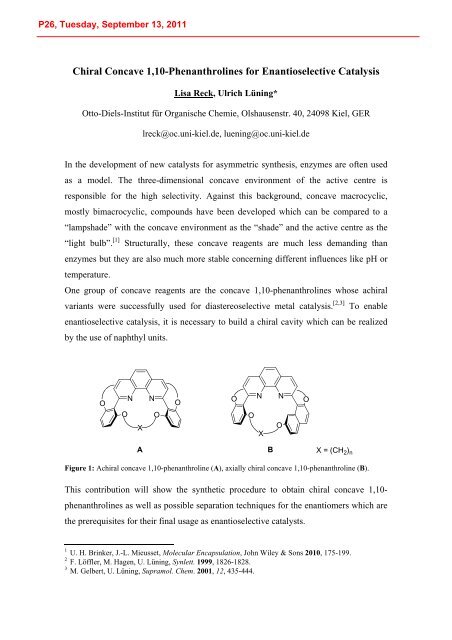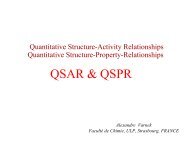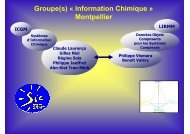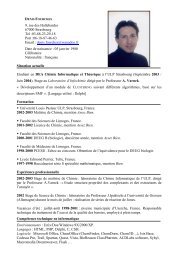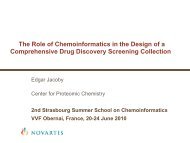International Summer School PROGRAM - Laboratoire d'Infochimie ...
International Summer School PROGRAM - Laboratoire d'Infochimie ...
International Summer School PROGRAM - Laboratoire d'Infochimie ...
Create successful ePaper yourself
Turn your PDF publications into a flip-book with our unique Google optimized e-Paper software.
Chiral Concave 1,10-Phenanthrolines for Enantioselective Catalysis<br />
Lisa Reck, Ulrich Lüning*<br />
Otto-Diels-Institut für Organische Chemie, Olshausenstr. 40, 24098 Kiel, GER<br />
lreck@oc.uni-kiel.de, luening@oc.uni-kiel.de<br />
In the development of new catalysts for asymmetric synthesis, enzymes are often used<br />
as a model. The three-dimensional concave environment of the active centre is<br />
responsible for the high selectivity. Against this background, concave macrocyclic,<br />
mostly bimacrocyclic, compounds have been developed which can be compared to a<br />
“lampshade” with the concave environment as the “shade” and the active centre as the<br />
“light bulb”. [1] Structurally, these concave reagents are much less demanding than<br />
enzymes but they are also much more stable concerning different influences like pH or<br />
temperature.<br />
One group of concave reagents are the concave 1,10-phenanthrolines whose achiral<br />
variants were successfully used for diastereoselective metal catalysis. [2,3] To enable<br />
enantioselective catalysis, it is necessary to build a chiral cavity which can be realized<br />
by the use of naphthyl units.<br />
O<br />
O<br />
N<br />
X<br />
A<br />
N<br />
O<br />
O<br />
O<br />
O<br />
N N<br />
X<br />
B<br />
O<br />
O<br />
X=(CH 2) n<br />
Figure 1: Achiral concave 1,10-phenanthroline (A), axially chiral concave 1,10-phenanthroline (B).<br />
This contribution will show the synthetic procedure to obtain chiral concave 1,10phenanthrolines<br />
as well as possible separation techniques for the enantiomers which are<br />
the prerequisites for their final usage as enantioselective catalysts.<br />
1 U. H. Brinker, J.-L. Mieusset, Molecular Encapsulation, John Wiley & Sons 2010, 175-199.<br />
2 F. Löffler, M. Hagen, U. Lüning, Synlett. 1999, 1826-1828.<br />
3 M. Gelbert, U. Lüning, Supramol. Chem. 2001, 12, 435-444.


